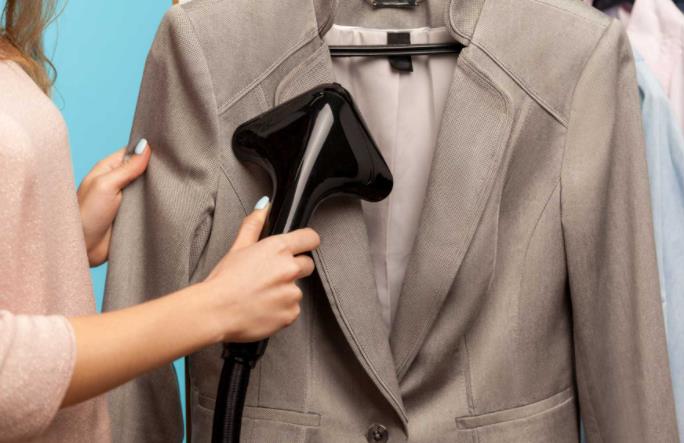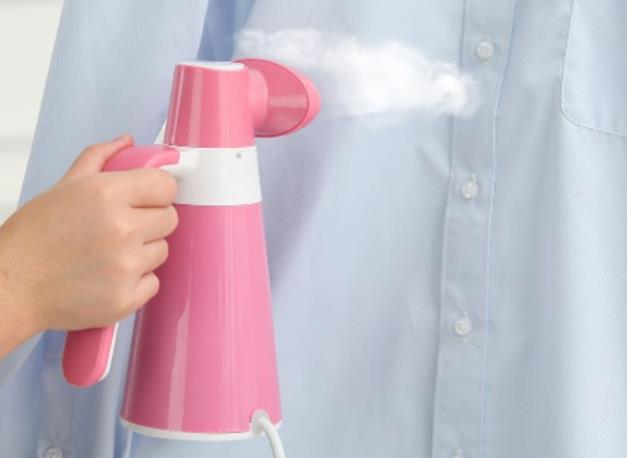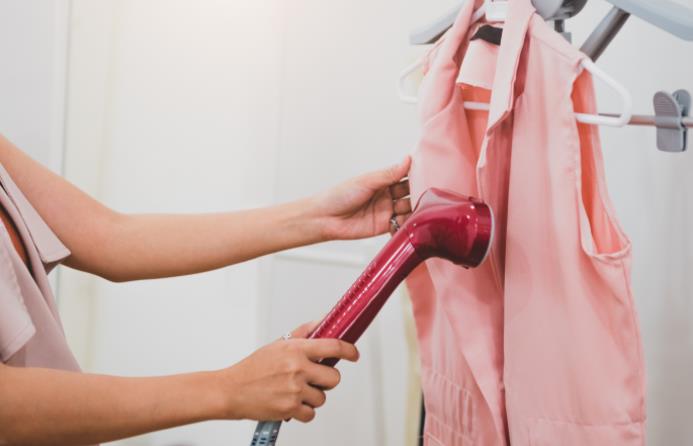Steaming of clothes is slowly becoming a modern trend in most of our homes. These appliances have rocked many households by storm, and they are proving beyond all doubts that they are indeed useful.
Steaming is not only a safe way of removing wrinkles but also the fastest way of straightening our clothes.

What Fabrics Can Be Steam Cleaned?
Steaming is an efficient way of removing wrinkles from various kinds of fabric. But just like most good things, it has its shortcomings. It is limited to specific types of fabrics. To cut a long story short, not all fabrics can be steamed.
Here is a list of fabrics that can be steamed:
-
- Cotton
- Silk
- Wool
- Polyester
This type of fabric can withstand heat from the steamer and still won’t be damaged at all; however, there are other types of fabric that can not withstand a lot of heat.
Even the slightest form of heat can cause a lot of damage to the fabric.
Here is a list of fabrics that cannot be steamed:
-
- Waxed jackets
- Suede
- Plastics
Steaming of clothes is becoming a modern trend in most of our homes. Steaming is not only a safe way of removing wrinkles but also the fastest way of straightening our clothes.
Clothes steam cleaner have rocked many households by storm, and they are proving beyond all doubts that they are indeed useful.
How to Steam Clean Clothes at Home?

When it comes to steaming, it is a common misconception that you only need a clothes steamer. However, depending on the type of steamer you are using, you might need other tools other than just your steamer.
Here is a list of tools and materials you might need while teaming your clothes.
- Tools
-
- Water
- Pegs
- Hanger
- A clothes steamer
- Brush
As easy as steaming may pose, we must note this is not always the case. Depending on the type of steamer and the type of clothing being steamed, this process may be complicated.
However, if you often steam, you will eventually become good at it despite opposing factors such as clothing type. Practice makes perfect.
Here are a few tips on how to steam different types of clothing.
-
Dresses

Steaming offers an advantage as it freshens the fabric and straightens it in the process. It quite knows that a steamer doesn’t work with dresses with creases or wrinkles.
Having this in mind, we are good to go and begin the steaming process; here are the steps to follow while steaming a dress
-
Step 1: Hang the dress on a hanger
Ensure the dress is well hanged on a well-spaced spot, and that will enable all areas of the dress to be easily accessible.
-
Step 2: Fill the steamer with water
When steaming any clothing, only distilled water is allowed. This ensures that there is no mineral build up in the steamer and ensures there is staining of the clothing in question.
-
Step 3: Warm up the steamer
Warming the steamer ensures you remove any residue that might have been held up when the steamer was used last. This is done by continuously pressing the main button on the steamer for approximately one minute.
-
Step 4: Steam the dress
Carefully hold the steamer at a distance from the dress with one hand, and with your other hand, hold the dress as you steam it.
Work in sections and ensuring you only steam each section for less than two minutes. Preferably steam the dress from the top heading to the bottom.
-
Step 5: Allow the dress to dry up
After steaming, some dresses may contain moisture from the process; ensure the dress is dried up completely before you wear it.
-
Shirts

When it comes to shirts, at least everyone owns one. With this type of attire, it is highly recommended that you use a handheld steamer. Here are a few pointers on how to remove creases from shirts using steamers.
-
Step 1: Hang the shirt on a hanger
Ensure the buttons of the shirt are buttoned up to prevent it from falling off.
Avoid wooden or plastic surfaces since they are easily affected by heat. And always opt for a glass surface like your shower door or a random window at home.
-
Step 2: Fill the steamer with distilled water
If distilled water is not readily available, then opt to boil water in a pot and cool a bit before pouring it into the steamer.
Consequently, please turn on the steamer and allow it to heat up. Hold it upright to prevent the steam from escaping.
-
Step 3: Start steaming the shirt
Start by steaming the stiffer parts of the shirt. Then, run the steamer along the button placket along the inner part, preferably use an upward and downward type stroke.
After you are done, unbutton the cuffs if it was a long-sleeved shirt and open them vertically, then steam the shirt. Proceed to the collar section hold up one end of the collar to properly steam.
-
Suits and jackets
For a suit to leave up to its name, it must contain a jacket. It is possible to steam a suit; however, the ease and possibility of this task are determined by the type of fabric it is made of.
Here are a few tips on how to steam suits and jackets; generally, the same steps apply to both clothing types.
-
Step 1: Turn the steamer on.
Turn the steamer on and heat up while pressing the main button to ensure there is a steady supply of steam and no build-up residue in the steamer.
-
Step 2: Start steaming the suit
However, depending on the type of fabric the suit is made of, hold the steamer at a reasonable distance from the fabric. Please do not pull the fabric while steaming.
It may cause damage to the jacket itself. Start by steaming the outside part of the jacket, then proceed to the jacket’s inside part.
-
Blouses, tank tops, and sweaters

The first thing we need to acknowledge is that this type of clothes is very delicate, and as a result, we need to proceed with caution when handling them.
Therefore, always check on the type of fabric it is made from before steaming. The steaming blouses, tank tops, and sweaters are probably the same, and only a few details change during the process.
Here are the steps to follow when steaming this type of clothing:
-
Step 1: Fill the water tank
Fill the steamer with distilled water and turn the steamer on for a while before you start using it to remove any residue that might have been caught up when you last used the steamer.
-
Step 2: Start steaming the clothing
Assuming you have already hanged your fabric properly, start steaming in a vertical motion from the top approaching the base.
Ensure you spend the minimum amount of time on each section to avoid damaging the fabric since we have already established this type of fabric is very sensitive.
-
Step 3: This step only applies to sweaters
Remove the sweater from the hanger, straighten it out with your own hands and finally fold it appropriately.
-
Wrinkled bra
Bras come with many responsibilities and challenges, for example, keeping it neat and clean. Below are the easiest way to remove creases from your bra using a steamer.
-
Step 1: Use your hands precisely your fingers to try and rub out creases from your bra.
Do this until most of the wrinkles are out.
-
Step 2: Hang the bra on a hanger with clips for affirm grip
Otherwise, use pegs for a firmer grip if you do not happen to own one.
-
Step 3: Fill the steamer with distilled water and turn it on to ensure a steady stream supply
Ensure the steam setting of the steamer is set to its lowest to deter further damage.
-
Step 4: Hold the steamer far away from the bra and start steaming
Use your fingers to smoothen out the wrinkles carefully while steaming. Continue doing this until the wrinkles are completely obliterated.
-
Velvet
Speaking of delicate material, did you know that velvet can’t even be ironed?
Yes, this is just how sensitive velvet tends to be. Steaming of any velvet material follows other procedures of steaming.
These few must-know rules can help you with this process:
1. Do not place your steamer so close to the velvet. Always place it more than 10 cm away to be safe.
2. While steaming, always follows the direction of the nap to prevent damage to the velvet.
How to Steam Clean Clothes on the Go?

If you are an on the road type of person, a handheld steamer is the best way to go to ensure your clothes maintain that neat and dashy look. Here are a few pointers on how to steam clean clothes on the go:
- Step 1: Ensure your clothes are clean and well hang up.
- Step 2: Fill the steamer with distilled water.
- Step 3: Hold the steamer in a vertical position, turn it on and allow it to heat up for a few minutes.
- Step 4: Begin working the collars and sleeves as you cautiously move towards the body.
- Step 5: Allow the cloth to dry up before wearing it properly.
Tips on How to Steam Clothes
Steaming of clothes is an easy function to perform, and It has helped reduced our workload by a large fraction. Straightening of our clothes could not be easier at this point, really. Here are a few key tips on how to steam clothes
When steaming clothes, always ensure that you use distilled water in the steamer to avoid mineral build up in the steamer.
- Always hang your clothes on a safe surface, a surface that won’t be affected by steam.
- While always steaming steam from top to bottom in a vertical motion.
- Before you start to steam, consider the type of fabric to be steamed as some fabrics cannot be steamed.
- Do not wear steamed clothing until it is completely dry.
FAQs
Can I put steamer directly on clothes?
As mentioned above, a steamer is a handy appliance, but it comes with a lot of instructions on how to use it.
if the appliance is not safely and properly used, it can lead to some major implications, especially on the fabric in question.
Some clothes have heavy wrinkles, and we might be tempted to put the steamer directly on them.
Are cloth steamers worth it?
Yes, they are! Cloth steamers have proven beyond all means that they are indeed handy and useful, unlike irons, though.
These appliances have become even handier when we are traveling, and that dress or shirt we intend to wear is a bit wrinkled.
Conclusion
As we advance into modern times, we find that we have no choice but to move with the tides. Yes, iron boxes have proven to be handy.
However, a better, faster, and safer appliance has been introduced into the market, and I honestly can not come up with an excuse as to why you shouldn’t opt for steamers.
